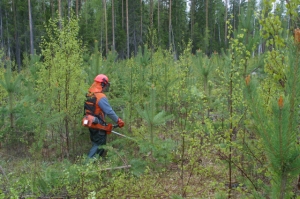Young forest stands need care
Soili Haikarainen, Saija Huuskonen and Johanna Routa from the Natural Resources Institute (Luke), Finland, examine the benefits of carrying out juvenile stand management practices to secure the stand’s future, based on a recent research paper published in Forests.

Motor manual tending in a pine seedling stand. Photo:Erkki Oksanen, Natural Resources Institute Finland
Stand management secures valuable sawlog stems
Juvenile stand management practices have a significant role in even-aged stand management. Young trees have a high potential to grow into good-quality and valuable sawlog stems. Tending practices carried out at an early age have long-lasting effects for the stand’s future.
In the regeneration phase, much effort has usually been put into a stand: the soil has been prepared, appropriate tree species have been selected, the high quality and genetically improved seeds and plants have been used, or the best seeding trees have been left to the site.
So why leave a young stand unattended when considerable effort has been invested in the first place? Without carrying out good management practices the potential of a juvenile stand is not fully exploited. In the worst case, tree species other than what was initially intended for the site may flourish. Conversely, good stand management rests on allowing the selected trees to be able to grow into valuable sawlog stems.
Focus on tending
Juvenile stand management, called tending, is a very important part of the even-aged stand management practice which is a common forestry approach in Nordic countries. Using that approach forest stands are managed by rotations, from regeneration to the final cut.
Tending essentially refers to the practice of silvicultural treatments where undesired broadleaves and other competing vegetation are removed from the juvenile stand, and the density of retained trees is set to the appropriate level in relation to the wood production potential of the site.
Tending may include two separate treatments: early cleaning and precommercial thinning. In the first one, abundant fast-growing broadleaves create a need for controlling competition. In subsequent years, precommercial thinning is generally needed to control the overall structure and stem density in a forest stand.
Why is tending still often neglected?
This phenomenon clearly can be seen in the results of forest inventories which show the high proportion of unattended juvenile stands. In principle, tending is a laborious and quite expensive task. It is usually done manually with a clearing saw. The mechanisation of tending is developing at a slow rate and, presently, there is no other competitive method that can be used other than the currently most cost-efficient and standard manual method.
In the juvenile stage of forest growth, the stand structure can change very quickly. Sometimes the rapidity of changes generated by fast growth come as a surprise to some, and that is when stand treatment should be undertaken quickly because any delays will result in a more labour-intensive and expensive operation.
Initial tending investment brings future returns
Another reason for neglecting the job of tending is that the benefits of the work can be seen only after many years, or even decades. Additionally, tending increases costs in the early phases of rotation, and so do not provide any returns (stumpage earnings) until many years later. Thus, if the rate of interest is set high, tending could easily be considered as being unprofitable.
The benefits of tending have been reported in several studies which are based on empirical stand-level data. Tending affects the development of trees and stands in several ways. Removing competing vegetation increases the growth of the released trees and enhances the yield of commercial wood. Controlling stand density by thinning accelerates the diameter and volume increment of the stems and enhances the development of the crowns, although thinning is known to reduce total yield. Positive impacts of tending on stand development are further improving the total profitability of forest management.
Scenario analysis helps identify the effects of delayed tending
By scenario analysis, including representative datasets (from national forest inventories) and stand development simulations, tending can be examined by larger forestry regions compared to the stand-level studies. It is possible to forecast at a regional level how many euros or cubic meters of sawlogs are put at stake when tending is delayed or neglected.
The results can be compared to the current level or to the suggested level of tending in the region (for example, when the work has been done as recommended in the local forest management guidelines). Also, the differences between geographical areas or between site fertility levels in tending profitability can be evaluated. The regional or national level results can be used in forest advisory work or even in forest policy making. Furthermore, results may help in the operational-level planning when selecting different sites and stands for tending in relation to the available resources.
T4E study points to regional scenarios to enhance profitability
As has been shown in previous stand levels studies, the regional level studies also showed the importance of tending. In a recent scenario analyses, implemented under Finnish conditions, it was shown that tending is a profitable silvicultural practice when modest interest rates were applied. Although the silvicultural costs increased initially the stumpage earnings usually increased more, and thus compensated the early investment. However, the profitability of tending decreased from south to north due to generally lower growth rates towards the north which resulted in a slower compensation rate of the early investment.
Timing of tending is also important. Even a short delay clearly increases the tending costs. Both delaying and neglecting tending points to significant losses, especially in sawlog removals and stumpage earnings.
Timely tending is most important on fertile sites
According to the results, the highest financial gain from tending, under Finnish conditions, can be reached in spruce stands on fertile sites. These are precisely the stands where delaying or neglecting tending causes the most harm. In fertile sites, the growth rate of trees is high, and the situation changes from “timely” to “delayed” very quickly, in a couple of years. Therefore, for operational forestry these sites can be classified as priority stands to take care of when conducting timely tendings.
Applying timely treatments in a juvenile stand results in an earlier prospect for the first commercial thinning with a larger stem size of removed trees and no need for clearing before thinning. Final cutting, defined by stand mean diameter, will also be executable earlier. Stands tended in the juvenile stage produce more sawlogs, but less pulpwood. Thus, tending improves a nationwide potential for increasing valuable sawlog production.
The TECH4EFFECT Study
To read the study: “Does juvenile stand management matter? Regional scenarios of the long-term effects on wood production” click HERE.
Authors: Haikarainen S.; Huuskonen, S.; Ahtikoski A.; Lehtonen M.; Salminen H.; Siipilehto J.; Korhonen K.T.; Hynynen J.; Routa J.
Related paper:
Huuskonen S, Haikarainen S, Sauvula-Seppälä T, Salminen H, Lehtonen M, Siipilehto J, Ahtikoski A, Korhonen KT, Hynynen J (2020) Benefits of juvenile stand management in Finland – impacts on wood production based on scenario analysis. Forestry: An International Journal of Forest Research, Volume 93, Issue 3, April 2020, Pages 458–470. To read this paper click HERE.
This project has received funding from the Bio Based Industries Joint Undertaking under the European Union’s Horizon 2020 research and innovation programme under grant agreement No 720757.


